Search:
Powered by
Website Baker
Price’s 1864 Missouri Raid – Little Blue River – October 21, 1864 |
| Posted by The Muse (themuse) on Oct 21 2013 |
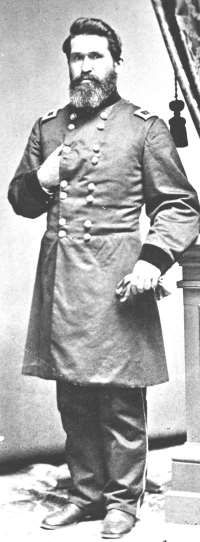 On October 19, 1864 near Lexington, Missouri, the Confederate Army of Missouri had skirmished with a detachment of Federal Volunteers from Kansas. Overwhelmed by numbers, the Federals, under the command of Major General James G. Blunt, had fallen back to the Little Blue River, about seven miles east of Independence, Missouri. Blunt thought the ground just west of the Little Blue River offered an excellent location to make a stand against the Confederates. He sent a message to Major General Samuel R. Curtis at 8:00 a.m. on October 20. [1]
On October 19, 1864 near Lexington, Missouri, the Confederate Army of Missouri had skirmished with a detachment of Federal Volunteers from Kansas. Overwhelmed by numbers, the Federals, under the command of Major General James G. Blunt, had fallen back to the Little Blue River, about seven miles east of Independence, Missouri. Blunt thought the ground just west of the Little Blue River offered an excellent location to make a stand against the Confederates. He sent a message to Major General Samuel R. Curtis at 8:00 a.m. on October 20. [1]
I shall fall back west of the Little Blue and halt at the first good position that I can find forage, and wait orders. Subsistence and ammunition must be sent forward to me without delay … Much depends now on our prompt action and concentration with Rosecrans' forces … If we mass our forces in the right position, and do it rapidly, we can move against Price in force and crush him.
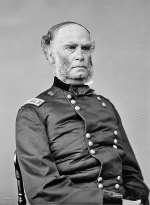 Major General Curtis was digging in east of Kansas City along the Big Blue River. Curtis was not interested in moving his forces east to the Little Blue. He had had enough trouble convincing the Kansas State Militia to cross the state line and move as far east as the Big Blue. Curtis sent a terse reply to Blunt. [2]
Major General Curtis was digging in east of Kansas City along the Big Blue River. Curtis was not interested in moving his forces east to the Little Blue. He had had enough trouble convincing the Kansas State Militia to cross the state line and move as far east as the Big Blue. Curtis sent a terse reply to Blunt. [2]
I have no time to explain. Your forces must take position here … The militia will not go farther forward, and the Big Blue must be our main line for battle … Leave two howitzers, and, say, 400 men at the Little Blue, and come back yourself with the remainder. Probably Moonlight better be left in command of that point, not to fight a battle, but to delay the rebel approach and fall back to our main force.
Major General James Blunt did not have a lot of respect for his commanding officer. He continued to argue his case for staying at the Little Blue in his reply back to Curtis. [3]
My command is in camp on west side of the [Little] Blue, in a strong position--that I can defend this line against a largely superior force. Have plenty of forage for the present. Have sent forward scouting parties to the front. My cavalry horses are considerably fatigued … This is the place to make the fight, if the enemy advance in force on this line. I would suggest that you come down and examine this position if you have time.
But Blunt obeyed his commander’s orders and withdrew back towards Kansas City where Major-General Samuel R. Curtis was establishing the Federal line of defense. Blunt described the withdrawal in his official report. [4]
At 9 a.m. of the 20th I reached the crossing of the Little Blue, nine miles east of Independence, and finding a strong natural position for defense on the west side of that stream … I was ordered by the general commanding to leave four squadrons at that point as an outpost and move with the remainder of my command to Independence … In pursuance of these instructions, I left Colonel Moonlight … with instructions to burn the bridge across the Blue if the enemy advanced in force, and to make such resistance as he could.
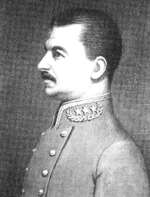 Confederate Major-General Sterling Price had continued his movements west towards Kansas City, Missouri. On October 20, Price encamped at Fire Creek Prairie, about 10 miles from the Little Blue River. On October 21, Price sent Major-General John S. Marmaduke's division ahead towards Independence, Missouri. Colonel Colton Greene, commanding the Third Missouri Cavalry Regiment in Marmaduke's Division, described the action at the Little Blue River in his official report: [5]
Confederate Major-General Sterling Price had continued his movements west towards Kansas City, Missouri. On October 20, Price encamped at Fire Creek Prairie, about 10 miles from the Little Blue River. On October 21, Price sent Major-General John S. Marmaduke's division ahead towards Independence, Missouri. Colonel Colton Greene, commanding the Third Missouri Cavalry Regiment in Marmaduke's Division, described the action at the Little Blue River in his official report: [5]
About midday my regiment [left] the main road to [cross the] Little Blue River below the bridge which was destroyed. I moved rapidly across the river … The enemy, who was in greatly superior force, vigorously pressed his advantage. He was twice repulsed, when he began to flank me both on the right and left. The moment was critical … I took charge of the battery … and then ordered rapid volleys of blank cartridges to be fired. It produced the desired effect. The enemy fell back and was charged by us.
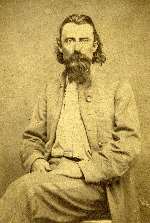 Marmaduke’s men were having trouble moving against the strong position held by the Federals. Confederate Brigadier General Jo Shelby ordered his men to Marmaduke’s support which he described in his official report. [6]
Marmaduke’s men were having trouble moving against the strong position held by the Federals. Confederate Brigadier General Jo Shelby ordered his men to Marmaduke’s support which he described in his official report. [6]
I … crossed Little Blue by wading. Finding General Marmaduke hard pressed and greatly outnumbered, I threw forward [my Division] and the fight opened fast and furious. The enemy held a strong position behind hastily constructed works of logs and earth, stone fences, and deep hollows and ravines … After great difficulty and hard work my artillery got over the stream and opened a heavy fire from a beautiful position … the enemy was driven clearly from the field.
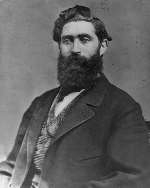 Having been ordered back to Independence by Curtis, Major-General James G. Blunt left Colonel Thomas Moonlight, commanding the Second Brigade, at the bridge over the Little Blue River with instructions to delay Price's advance. Moonlight did not have his entire brigade with him at the bridge. Moonlight described the situation in his official report. [7]
Having been ordered back to Independence by Curtis, Major-General James G. Blunt left Colonel Thomas Moonlight, commanding the Second Brigade, at the bridge over the Little Blue River with instructions to delay Price's advance. Moonlight did not have his entire brigade with him at the bridge. Moonlight described the situation in his official report. [7]
On [October 21st we] took up position on the west bank of the Little Blue, eight miles from Independence, left alone to watch the enemy, fight him at the crossing, and burn the bridge … [With] my force being reduced, and the stream being fordable at almost any point, it was no easy matter to hold an enemy so numerous and active, all being cavalry. [As the enemy advanced, the bridge was] set on fire and held until it was fairly burning, after which [they] fell back on the hill and joined the command, who then opened fire on the enemy … the enemy were crossing at all points.
When Blunt met up with Curtis, he continued to argue with his commander about the strength of the position at the Little Blue River. By now both men knew that Colonel Moonlight was being pressed hard by the Confederates and was falling back. Curtis decided to go to the front and see for himself. Taking the First Brigade, Colonel Charles R. Jennison commanding, and the Fourth Brigade, Colonel James H. Ford commanding, with them, both Curtis and Blunt quickly moved east towards the Little Blue River. Blunt described these movements in his official report. [8]
I was directed to move with all the volunteer force back to the Little Blue … the command was now pressed forward as rapidly as possible, but on arriving upon the field I found that the small force under Colonel Moonlight, although making a stubborn resistance, had been forced back by superior numbers …
Colonel Thomas Moonlight must have been pleased to see the reinforcements brought forward by Curtis and Blunt. Moonlight described this in his official report. [9]
Being menaced on all sides and the object for which I was left accomplished, the command slowly fell back about two miles, fighting. A favorable piece of ground here presenting itself, a new line of battle was formed on the left of the Independence road, and we slowly began to drive the enemy back over the ground again, dismounting every man for the purpose of shelter behind stone walls, fences, and houses … By this time General Blunt had come up, and other troops were being thrown in on the right to my support.
The Federals now had about 2,000 troops and 15 artillery pieces just west of the Little Blue River. They were facing four brigades from Marmaduke's and Shelby's Divisions. Blunt described the action in his official report. [10]
Arriving upon the field I found that … Colonel Moonlight, although making a stubborn resistance, had been forced back by superior numbers … a gallant attempt was made to push back the enemy and retake the ground we had lost … but the vastly superior numbers of the enemy enabling them to push forward heavy flanking columns on my right and left, compelled me to fall back in the direction of Independence … The fighting lasted nearly six hours … ceasing about 4 p.m.
A few years after the war, James G. Blunt wrote about the events surrounding the Battle of the Little Blue River, in which he was more critical of some of Curtis's decisions: [11]
Upon my arrival at Independence that evening I urged upon General Curtis the mistake that had been made in abandoning the Little Blue, and demonstrated to him that when the enemy had crossed that stream, they would be in an open country free to move in any direction they chose, and that it was not reasonable to suppose they would move against a fortified position, when it was much easier for them to pass around our flank and rear …
[During the fighting] Gen'l Curtis came up, and by interfering with the disposition of my troops without conveying his orders through me, threw the command into confusion that might have been avoided. He soon after left the field and gave me no further trouble during the day, except, on his return to Independence, he ordered back my ammunition wagons which I had ordered to the front, which circumstance came near proving disastrous to the whole command …
In this day's fighting our loss was slight while the enemy were punished severely. I have never for a moment doubted that had I been allowed to remain on the Little Blue the night of the 20th, and received the reinforcements I asked for, the contest would have been settled there in a manner entirely satisfactory to our arms. I had no doubt of my ability in that position to have held the ground until Pleasanton could come up when we could have crushed Price's command.
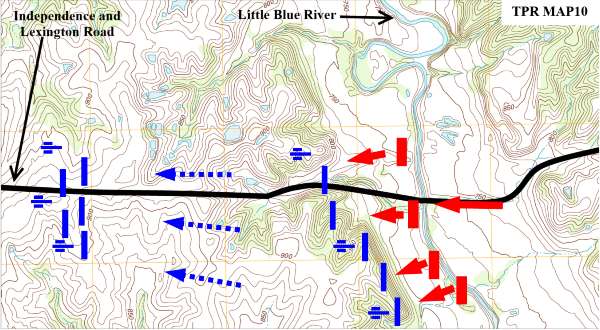
[1]OR Series 1, Volume 41, Part 4, 144-145.
[2]OR Series 1, Volume 41, Part 4, 145.
[3]OR Series 1, Volume 41, Part 4, 145-146.
[4]OR Series 1, Volume 41, Part 1, 574.
[5]OR Series 1, Volume 41, Part 1, 633-634, 690.
[6]OR Series 1, Volume 41, Part 1, 657.
[7]OR Series 1, Volume 41, Part 1, 592.
[8]OR Series 1, Volume 41, Part 1, 476, 574-575, 583-584, 607-608.
[9]OR Series 1, Volume 41, Part 1, 592.
[10]OR Series 1, Volume 41, Part 1, 476, 574-575, 583-584, 607-608.
[11]Blunt, General Blunt's Account of His Civil War Experiences, 255-257.
Last changed: Oct 21 2013 at 7:02 PM
Back